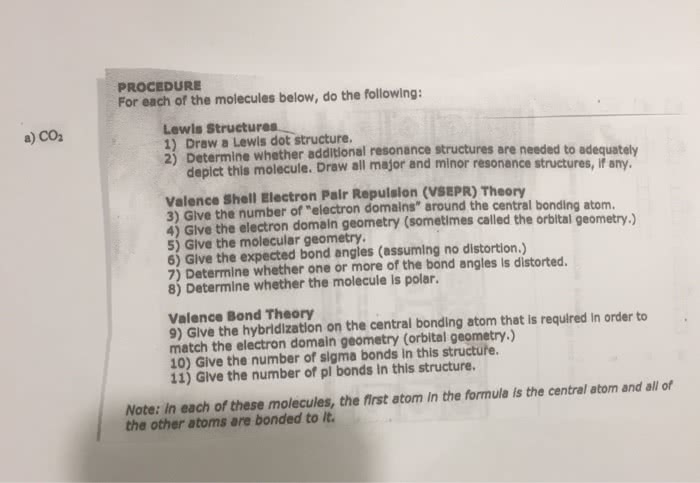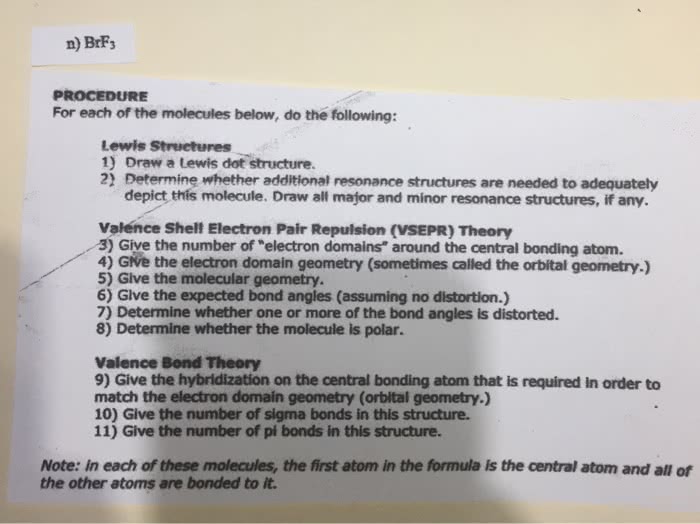CHE 110 Chapter Notes - Chapter 10: Hexafluoride, Chemical Bond, Pauli Exclusion Principle

Chapter 10 Chemical Bonding II: Molecular Geometry and Hybridization of Atomic Orbitals
I. Molecular Geometry
1. Valence-Shell Electron-Pair Repulsion (VSEPR) Model
1) Valence shell: outermost electron-occupied shell of atom that holds the
electrons involved in bonding
2) VSEPR Model: accounts for the geometric arrangements of electron pairs
around a central atom in terms of the electrostatic repulsion between electron
pairs
3) Two General Rules of the VSEPR Model
1. As far as electron-pair repulsion is concerned, double bonds and triple
bonds can be treated like single bonds.
1) Approximation is good for qualitative purposes
2) Realize that in reality, multiple bonds are larger than single bonds
– because there are two or three bonds between two atoms,
electron density occupies more space
2. If a molecule has two more more resonance structures, we can apply the
VSEPR model to any one of them.
1) Formal charges are usually not shown
2. Molecules in Which the Central Atom Has No Lone Pairs
1) AB2 ~ Beryllium Chloride, BeCl2
1. Bonding pairs repel each other so they must be at opposite ends of a
straight line in order for them to be as far apart as possible
2. ClBeCl angle is 180 and the molecule is linear
2) AB3 ~ Boron Trifluoride, BF3
1. Contains three covalent bonds, or bonding pairs
2. Trigonal planar because all four atoms lie in the same plane and the
three end atoms form an equilateral triangle, forming 120 angle
3) AB4 ~ Methane, CH4
1. Four bonding pairs, so geometry is tetrahedral
2. Tetrahedron has four sides, which are equilateral triangles
3. Central atom (C) is located at the center of the tetrahedron and other four
atoms are at the corners
4. Bond angles are all 109.5
4) AB5 ~ Phosphorus Pentachloride, PCl5
1. Only way to minimize repulsive forces among five bonding pairs is to
arrange PCl bonds in the form of a trigonal pyramid
1) Generated by joining two tetrahedrons along a common triangular
base
2. Central atom (P) is at the center of the triangle with surrounding atoms
positioned at 5 corners
3. Atoms above and below triangular plane occupy axial positions
4. Atoms in the triangular plane occupy equatorial positions
5. The angle between any two equatorial bonds is 120; the angle between
an axial bond and equatorial bond is 90; the angle between any two axial
bonds is 180
find more resources at oneclass.com
find more resources at oneclass.com

5) AB6 ~ Sulfur Hexafluoride, SF6
1. Most stable arrangement is an octahedron with eight sides
1) Generated by joining two square pyramids on a common base
2. Central atom (S) is at the center of the square base and the surrounding
atoms are at six corners
3. All bond angles are 90 EXCEPT the angles made by the bonds between
the central atom and the pairs of atoms that are diametrically opposite
each other and these have 180 angle
3. Molecules in Which the Central Atom Has One or More Lone Pairs
1) Three Types of Repulsive Forces
1. Between bonding pairs
2. Between lone pairs
3. Between a bonding pair and lone pair
2) General Decreasing Order for Repulsive Forces
1. Lone-Pair vs. Lone-Pair
2. Lone-Pair vs. Bonding-Pair
3. Bonding-Pair vs. Bonding-Pair
3) AB2E ~ Sulfur Dioxide, SO2
1. VSEPR treats double bonds as single bonds so SO2 can be viewed as
consisting of three electron pairs on the central S atom
2. Of these, two are bonding pairs and one is a lone pair
3. Overall arrangement of three electron pairs is trigonal planar
1) Because one of the electrons is a lone pair, SO2 has a bent shape
4. Because lone-pair vs. bonding pair > bonding pair vs. bonding pair, the
two sulfur-to-oxygen bonds are pushed together slightly, giving an angle
of less than 120
4) AB3E ~ Ammonia, NH3
1. Overall arrangement of four electron pairs is tetrahedral
2. Because one of the electrons in NH3 is a lone pair, the geometry is
trigonal pyramidal (looks like a pyramid, with the N atom at the apex)
3. Lone pair repels bonding more strongly, three NH bonding pairs are
pushed closer together, giving the angle in ammonia to be less than
109.5
5) AB2E2 ~ Water, H2O
1. Two bonding pairs and two lone pairs
2. Overall arrangement in water is tetrahedral, same as ammonia
3. Unlike ammonia, water has two lone pairs on the central O atom and
these lone pairs tend to be as far from each other as possible
4. Two O-H bonding pairs are pushed toward each other, and predicted
greater deviation from tetrahedral angle than in ammonia
5. Angle is 104.5, geometry is bent
6) AB4E ~ Sulfur Tetrafluoride, SF4
1. Central sulfur has five electron pairs with trigonal bypyramidal
arrangement
2. In SF4 molecule, one of the electron pairs is a lone pair
3. Lone pair can occupy equatorial position or axial position
find more resources at oneclass.com
find more resources at oneclass.com





